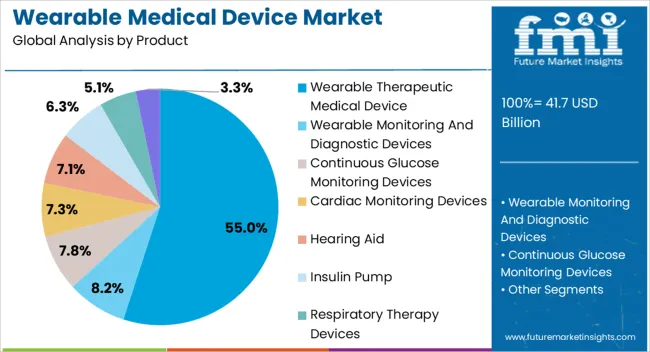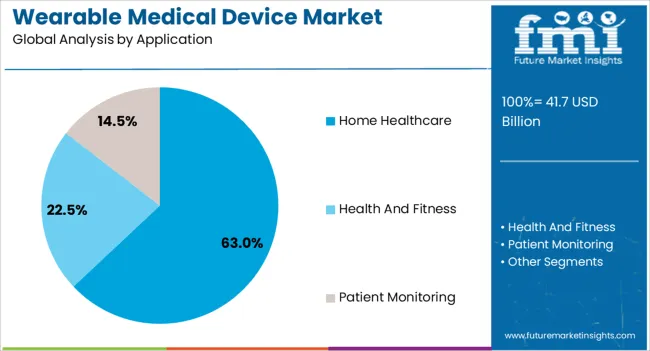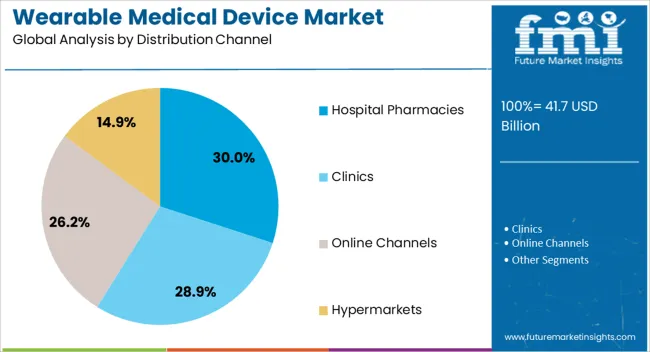The Wearable Medical Device market is experiencing significant growth driven by the rising demand for remote patient monitoring, personalized healthcare, and chronic disease management. The future outlook is shaped by increasing adoption of wearable technologies that allow continuous health tracking, early detection of medical conditions, and proactive intervention. Growing awareness about preventive healthcare, coupled with the aging global population and the prevalence of lifestyle-related diseases, is supporting market expansion.
Advancements in sensor technology, connectivity, and data analytics are enabling wearable devices to deliver accurate and real-time health insights, enhancing patient outcomes. The integration of wearable devices with telemedicine and mobile health applications is further increasing their utility, enabling seamless communication between patients and healthcare providers.
In addition, the shift towards home-based care and self-management of health conditions is driving the adoption of wearable medical devices As healthcare systems prioritize cost-effective and patient-centric solutions, wearable medical devices are expected to remain a critical component in modern healthcare delivery with sustained growth potential.

| Metric | Value |
|---|---|
| Wearable Medical Device Market Estimated Value in (2025 E) | USD 41.7 billion |
| Wearable Medical Device Market Forecast Value in (2035 F) | USD 91.6 billion |
| Forecast CAGR (2025 to 2035) | 8.2% |
The market is segmented by Product, Application, and Distribution Channel and region. By Product, the market is divided into Wearable Therapeutic Medical Device, Wearable Monitoring And Diagnostic Devices, Continuous Glucose Monitoring Devices, Cardiac Monitoring Devices, Hearing Aid, Insulin Pump, Respiratory Therapy Devices, and Health And Fitness Devices. In terms of Application, the market is classified into Home Healthcare, Health And Fitness, and Patient Monitoring. Based on Distribution Channel, the market is segmented into Hospital Pharmacies, Clinics, Online Channels, and Hypermarkets. Regionally, the market is classified into North America, Latin America, Western Europe, Eastern Europe, Balkan & Baltic Countries, Russia & Belarus, Central Asia, East Asia, South Asia & Pacific, and the Middle East & Africa.

The wearable therapeutic medical device product segment is projected to hold 55.00% of the Wearable Medical Device market revenue share in 2025, making it the leading product type. The growth of this segment has been driven by the increasing need for devices that assist in managing chronic conditions, promoting recovery, and delivering targeted therapies.
Continuous monitoring, combined with real-time feedback, enhances patient compliance and therapeutic effectiveness. The rising preference for non-invasive and portable medical solutions further supports the adoption of wearable therapeutic devices.
Moreover, technological advancements enabling integration with mobile applications, cloud platforms, and AI-powered analytics have expanded the capabilities of these devices, making them more attractive for both patients and healthcare providers The segment’s prominence is reinforced by the growing trend of personalized healthcare, where treatment regimens can be customized based on individual health data, thereby driving consistent revenue growth.

The home healthcare application segment is expected to account for 63.00% of the Wearable Medical Device market revenue share in 2025, establishing it as the leading application segment. Growth in this segment is influenced by the increasing demand for remote patient monitoring and self-care solutions that reduce hospital visits while maintaining high-quality healthcare outcomes.
Wearable devices enable continuous health monitoring, early detection of complications, and real-time communication with healthcare providers, enhancing patient safety and convenience. The adoption of home healthcare solutions has been further accelerated by the need to manage chronic diseases, aging population trends, and the shift toward value-based care models.
Additionally, the integration of wearable devices with telehealth services allows healthcare providers to track patient progress remotely and optimize treatment plans efficiently The combination of convenience, accessibility, and data-driven insights continues to drive the dominance of the home healthcare segment in the market.

The hospital pharmacies distribution channel segment is anticipated to hold 30.00% of the Wearable Medical Device market revenue in 2025, making it a significant contributor to market growth. This segment benefits from the established presence of hospital pharmacies as reliable points of access for patients requiring medical devices for therapeutic and monitoring purposes.
The integration of wearable devices into hospital-managed care programs ensures proper guidance, device calibration, and patient support, enhancing adherence and clinical outcomes. Moreover, hospital pharmacies serve as a critical link between manufacturers and healthcare providers, facilitating efficient supply chains and distribution of technologically advanced wearable devices.
The increasing collaboration between healthcare institutions and device manufacturers has strengthened the role of hospital pharmacies in promoting wearable medical devices As demand for clinically supervised and prescription-based wearable solutions grows, the hospital pharmacy segment continues to play an essential role in supporting market expansion.
Increasing Frequency of Lifestyle Diseases to Drive Market Development
The rising prevalence of sedentary and inactive lifestyles, as well as the growing trend of eating out, has increased the number of lifestyle conditions such as diabetes and hypertension, resulting in a rise in growth for the wearable medical device market throughout the projection period.
The above conditions necessitate continual monitoring and tracking of physiological indicators such as blood sugar levels and blood pressure, which is motivating market participants to integrate healthcare data with healthcare equipment so that experts may access your information in real time.
Integration of AI and 5G connectivity to Drive Market Growth
Wearable medical devies are becoming increasingly reliant on artificial intelligence and 5G connectivity. 5G, artificial intelligence, and machine learning (ML) may be used to identify possible diagnosis and therapies for a given patient. Al can help identify which patients are more likely to experience postoperative difficulties, allowing healthcare organizations to provide early treatments.
Real time knowledge with a large volume of data needs reliable and high bandwidth networks. Healthcare businesses may leverage 5G networks to provide the finest treatment possible in real time, no matter where the patients are. The use of developing sophisticated tools and technologies like as Al and 5G has the potential to generate revenue in the wearable medical device industry.
Growing Incidences of the Cybercrimes is expected to Impede Market Growth
The increasing frequency of cybercrime and medical data theft has raised worries among significant corporations. The digital world is vulnerable to a large variety of cyber assaults and threats, which expose patients sensitive information. The rising supremacy of cyber thieves, along with the widespread use of cellphones and cutting edge software, is harming industry development.
Global wearable medical device demand increased at a CAGR of 10.7% from 2020 to 2025. For the next ten years (2025 to 2035), projections are that expenditure on wearable medical device will reach a CAGR of 8.2%.
This increase can be linked to a numerous factor, including technological developments, the rising frequency of chronic illnesses, and a greater emphasis on preventative healthcare. Wearable devices have developed as critical instruments in healthcare, allowing for continuous monitoring of vital signs, tracking fitness measures, and remote patient care.
The wearable medical device market forecast implies a slightly slower pace than the preceding era, representing a strong increase driven by continued innovations and changing healthcare demands The increased frequency of chronic illnesses, along with an aging population, highlights the importance of continuous health monitoring and disease management solutions.
The increased emphasis on preventative healthcare and customized treatment drives up demand for wearable technologies that enable proactive health management and early intervention. Continuous advances in wearable technology, such as downsizing, longer battery life, and increased data accuracy, are projected to extend the application reach and appeal of the devices in a variety of healthcare contexts.
The following table shows the estimated growth rates of the top three markets. India and Singapore are set to exhibit high wearable medical device market growth, recording CAGRs of 18.4% and 13.1%, respectively, through 2035.
| Countries | CAGR 2025 to 2035 |
|---|---|
| India | 18.4% |
| Singapore | 13.1% |
| France | 8% |
| United Kingdom | 7.8% |
| United States | 6.5% |
India is projected to ascend at a CAGR of 18.4% during the forecast period. Government measures are driving the Market demand for wearable medical device in India. With an emphasis on improving healthcare accessibility and cost, the government has undertaken a number of efforts to encourage the use of wearable medical devices.
Programs such as the National Health Mission (NHM) and Ayushman Bharat raise awareness about preventative healthcare and encourage the use of wearable devices for remote patient monitoring and early illness diagnosis. Government programs that encourage innovation and investment in the healthcare industry are playing an important role in expanding the use of wearable medical devices, eventually enhancing healthcare outcomes and quality of life for the population of India.
France is predicted to augment at a CAGR of 8% during the projected period. Wearable medical devices are becoming increasingly popular in France, owing to the technological advancements. New technologies are transforming healthcare delivery by offering real time monitoring and personalized health information. From smartwatches that track vital signs to wearing patches for continuous glucose monitoring, the market is seeing a wide range of wearable medical solutions.
The devices provide exceptional ease and mobility, allowing patients to manage their health more proactively and reducing the need for frequent hospital visits. The incorporation of AI and machine learning algorithms improves the operation of the devices, allowing for predictive analytics and early diagnosis of health risks. Wearable medical technologies are set to play an increasingly important part in the healthcare ecosystem of France, allowing individuals to take charge of their health and resulting in better patient outcomes.

The United States is expected to augment at a CAGR of 6.5% during the assessment period. The growing expenses of healthcare in the United States have fueled a spike in demand for wearable medical devices. As traditional healthcare costs climb, people and providers are looking for more affordable ways to monitor health and manage chronic illnesses.
Wearable medical technologies provide an appealing alternative by allowing remote patient monitoring, early intervention, and individualized treatment while reducing the need for frequent hospital visits and costly procedures. This trend toward wearable technology is motivated by the potential to minimize healthcare expenses associated with avoidable problems, hospital readmissions, and redundant medical procedures.
| Segment | Home Healthcare (Application) |
|---|---|
| Value Share (2025) | 63% |
The home healthcare segment is forecasted to attain a market share of 63% in 2025. The ongoing innovations in technology are revolutionizing the healthcare industry. Home healthcare is a convenient way for elderly people to keep their health in check from the comfort of their home which is a key factor propelling the growth of this segment.
For people with hectic work schedules, home healthcare is a good option to look after their health without stepping out of their daily routines. This segment also empowers the individuals to take better decisions regarding their health further driving the demand for the home healthcare during the projected period.
| Segment | Wearable Therapeutic Medical Device (Product) |
|---|---|
| Value Share (2025) | 55% |
The wearable therapeutic medical device segment is anticipated to garner a market share of 55% in 2025. This growth is the result of the segment being an affordable and convenient option for consumers and is extremely helpful in targeting conditions which are frequently remain unaddressed by the healthcare systems.
The devices in focus mostly target chronic diseases such as diabetes and respiratory disease. According to WHO, 77% of deaths happens yearly due to chronic diseases which can be mitigated by detection, monitoring and timely treatment. All the above factors contribute to the demand for wearable therapeutic medical device segment is going to thrive in the next ten years.

The global wearable medical device market is highly fragmented. Leading wearable medical device manufacturers are continuously working to produce new devices with better capabilities.
Leading market players are combining cutting edge wearable medical devices that give precise measurements of critical indicators like as heart rate, temperature, and blood pressure. The key market players have used strategies such as partnerships, acquisitions, collaborations, new product launches and approvals, the establishment of new manufacturing facilities, and a shift to online shopping platforms to gain a competitive advantage in the global wearable medical device market and expand their global footprint.
Recent Developments
In March 2025, Siemens has developed one of the most innovative circuit protection devices in the world, utilizing cutting edge electronic switching technology. SENTRON ECPD (Electronic Circuit Protection Device) electrically disables circuit faults and, if necessary, trips the mechanical isolating contact downstream. Until date, disconnection was only performed via electromechanical components.
In January 2025, Owlet Baby Care, a pioneer in smart newborn monitoring, has launched Dream Sock® and BabySat™, two medical devices with recent FDA approvals. Both innovations give real time health information with medical grade precision, as well as substantial gains in at home baby care.
Medtronic plc, Siemens AG, Fitbit Inc., Bayer AG, Panasonic Corporation, Animas Corporation - Johnson and Johnson, Smiths Medical - A Smiths Group Company, Koninklijke Philips N.V., Owlet Baby Care, OMRON Corporation Hoffmann-La Roche Ltd and Rest Devices Inc., are some of the key players in this market.
The wearable medical device market is classified into (wearable monitoring and diagnostic devices (foetal and obstetric devices (wearable foetal monitors and infant motion sensing monitors), continuous glucose monitoring devices, cardiac monitoring devices (wearable heart rate monitors, wearable pulse oximeters and wearable blood pressure monitors), wearable therapeutic medical device, hearing aid, insulin pump, respiratory therapy devices (sleep apnea devices and non-invasive ventilation) and health and fitness devices.
The wearable medical device market is classified into patient monitoring, home healthcare and health and fitness.
The wearable medical device market is classified into hospital pharmacies, clinics, online channels and hypermarkets.
Analysis of the Wearable Medical Device market has been carried out in key countries of North America, Latin America, Western Europe, South Asia, East Asia, Eastern Europe and Middle East & Africa.
The global wearable medical device market is estimated to be valued at USD 41.7 billion in 2025.
The market size for the wearable medical device market is projected to reach USD 91.6 billion by 2035.
The wearable medical device market is expected to grow at a 8.2% CAGR between 2025 and 2035.
The key product types in wearable medical device market are wearable therapeutic medical device, wearable monitoring and diagnostic devices, continuous glucose monitoring devices, cardiac monitoring devices, hearing aid, insulin pump, respiratory therapy devices and health and fitness devices.
In terms of application, home healthcare segment to command 63.0% share in the wearable medical device market in 2025.






Our Research Products

The "Full Research Suite" delivers actionable market intel, deep dives on markets or technologies, so clients act faster, cut risk, and unlock growth.

The Leaderboard benchmarks and ranks top vendors, classifying them as Established Leaders, Leading Challengers, or Disruptors & Challengers.

Locates where complements amplify value and substitutes erode it, forecasting net impact by horizon

We deliver granular, decision-grade intel: market sizing, 5-year forecasts, pricing, adoption, usage, revenue, and operational KPIs—plus competitor tracking, regulation, and value chains—across 60 countries broadly.

Spot the shifts before they hit your P&L. We track inflection points, adoption curves, pricing moves, and ecosystem plays to show where demand is heading, why it is changing, and what to do next across high-growth markets and disruptive tech

Real-time reads of user behavior. We track shifting priorities, perceptions of today’s and next-gen services, and provider experience, then pace how fast tech moves from trial to adoption, blending buyer, consumer, and channel inputs with social signals (#WhySwitch, #UX).

Partner with our analyst team to build a custom report designed around your business priorities. From analysing market trends to assessing competitors or crafting bespoke datasets, we tailor insights to your needs.
Supplier Intelligence
Discovery & Profiling
Capacity & Footprint
Performance & Risk
Compliance & Governance
Commercial Readiness
Who Supplies Whom
Scorecards & Shortlists
Playbooks & Docs
Category Intelligence
Definition & Scope
Demand & Use Cases
Cost Drivers
Market Structure
Supply Chain Map
Trade & Policy
Operating Norms
Deliverables
Buyer Intelligence
Account Basics
Spend & Scope
Procurement Model
Vendor Requirements
Terms & Policies
Entry Strategy
Pain Points & Triggers
Outputs
Pricing Analysis
Benchmarks
Trends
Should-Cost
Indexation
Landed Cost
Commercial Terms
Deliverables
Brand Analysis
Positioning & Value Prop
Share & Presence
Customer Evidence
Go-to-Market
Digital & Reputation
Compliance & Trust
KPIs & Gaps
Outputs
Full Research Suite comprises of:
Market outlook & trends analysis
Interviews & case studies
Strategic recommendations
Vendor profiles & capabilities analysis
5-year forecasts
8 regions and 60+ country-level data splits
Market segment data splits
12 months of continuous data updates
DELIVERED AS:
PDF EXCEL ONLINE
Medical Device Tester Market Size and Share Forecast Outlook 2025 to 2035
Medical Device Trays Market Size and Share Forecast Outlook 2025 to 2035
Medical Device Technology Market Size and Share Forecast Outlook 2025 to 2035
Medical Devices Market Size and Share Forecast Outlook 2025 to 2035
Medical Device Packaging Market Size, Share & Forecast 2025 to 2035
Medical Device & Equipment Tags Market Size and Share Forecast Outlook 2025 to 2035
Medical Devices Secondary Packaging Market Analysis by Material and Application Through 2035
Understanding Market Share Trends in Medical Device Packaging
Medical Device Analytical Testing Outsourcing Market Trends – Growth & Forecast 2024-2034
Wearable Medical Robots Market - Trends & Forecast 2025 to 2035
Medical Cleaning Devices Market Overview - Trends & Forecast 2025 to 2035
Medical EMR Input Device Market Size and Share Forecast Outlook 2025 to 2035
Wearable Pregnancy Devices Market Trends and Forecast 2025 to 2035
Wearable Computing Devices Market Analysis - Size, Share & Forecast 2025 to 2035
Wearable Healthcare Devices Market Size and Share Forecast Outlook 2025 to 2035
Cardiac Medical Device Market
Portable Medical Devices Market Analysis - Growth & Forecast 2025 to 2035
Homecare Medical Devices Market Outlook – Industry Growth & Forecast 2025 to 2035
Aesthetic Medical Device Market Analysis - Size, Share, and Forecast Outlook for 2025 to 2035
Medical Far Infrared Therapy Device Market Size and Share Forecast Outlook 2025 to 2035

Thank you!
You will receive an email from our Business Development Manager. Please be sure to check your SPAM/JUNK folder too.
Chat With
MaRIA